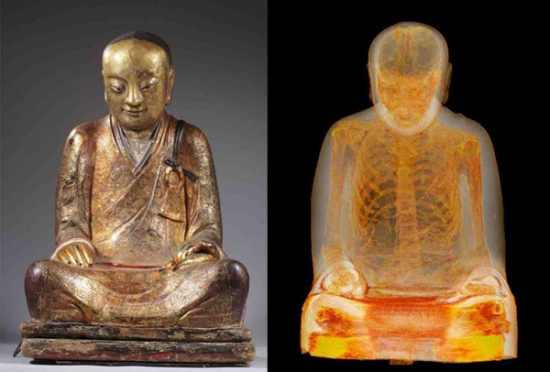
A CT scan shows a body, whose internal organs were removed, concealed in an ancient Chinese statue of a Buddha. (Photos provided by the Drents Museum)
A lawsuit has been filed in the Netherlands for the repatriation of a 1000-year-old Buddhist mummy stolen from Yangchun village in China's southeast province of Fujian.
It is believed to be in possession of Dutch national Oscar van Overeem, Dutch lawyer Jan Holthuis who represents the Chinese villagers in Dutch court proceedings told Xinhua.
The villagers told an Amsterdam court on June 8 that the Dutch collector did not acquire the statue in good faith and has no right to own the human remains of an identifiable person under Dutch law.
The Dutch collector lent the Buddha statue with a mummified monk inside for an exhibition in Hungary at the end of 2014. Chinese villagers who saw the reports of the exhibition in March 2015 believed that the statue is "Zhanggong Patriarch" stolen from their temple and wanted it repatriated.
The villagers appointed a group of Chinese lawyers and a Dutch lawyer to start legal proceedings both in China and in the Netherlands. Holthuis International Lawyers is "dominus litis" or master in the Dutch court proceedings.
GOOD FAITH IN QUESTION
Jan Holthuis, managing partner of the Dutch law firm, said: "Van Overeem should have exercised a higher level of due diligence at the time of acquisition to check whether the object was illegally traded. Van Overeem also said the statue was traded through Hong Kong, known for illegal trade of this kind of Buddha statues at that time. We know that he bought the statue from another Dutch trader in Asian art, who was also an informed person."
In a statement sent to media after the statue was withdrawn from the exhibition in Hungary, a spokesperson of the Dutch collector said "the owner of the mummy has been collecting Chinese art for almost three decades" and "the owner bought the sculpture in the Netherlands from a fellow collector who, at that time, was sharing his professional time between Hong Kong and Amsterdam and who was well acquainted with the local Hong Kong art scene."
"In late 1995 in Amsterdam, the current owner noticed the statue first in the fellow collector's collection and by mid 1996 agreed to acquire it. The previous owner shipped the statue from his Hong Kong studio to his Amsterdam residence while he, in turn, in the winter of 1994-1995 acquired the statue from a Chinese art friend in Hong Kong," according to the statement.
Under the Dutch Civil Code, the possessor must observe the necessary diligence (prudence) at the acquisition of ancient cultural objects. Holthuis said "in professional art trading circles it is known that this kind of old statue could never have been exported out of China without a permit. A professional buyer should have asked for provenance documents and export permit. Apparently, Van Overeem did not."


















































